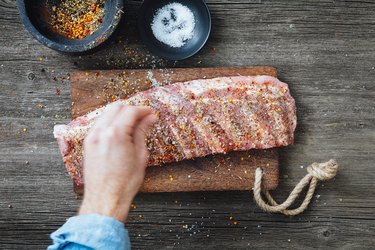
An array of mishaps, such as spillage or mistakes in measuring, can make a food too salty. If this happens, all is not lost. You can either camouflage the saltiness with other flavors or dilute it by adding more ingredients.
Tip
The best way to remove too much salt in cooking is to either add more liquid or make more of the recipe.
Video of the Day
Neutralize Salt in Food
When food is too salty, some cooks recommend masking the taste by mixing in other ingredients such as lemon juice or vinegar. Adding cream can also tone down salty flavor. Such camouflaging measures might make a dish more palatable, but just remember that the salt remains in the dish.
Video of the Day
If you have enough extra ingredients on hand, the Food Network advocates making more of the recipe to dilute the saltiness. For example, you can reduce too much salt in soup by adding more liquid. Water can wash out some of the flavor, so the use of salt-free broth is preferable. Throwing in extra vegetables from the crisper, or adding cooked rice, pasta or quinoa can absorb some of the salt.
Too much salt in macaroni salad can be fixed by adding a little vinegar rather than dressing or mayonnaise. However, the best way to salvage the dish is to add unsalted macaroni and vegetables to it, so the salt is distributed more widely.
How to Prevent Over-Saltiness
It's much easier to prevent over-saltiness than to fix it after it happens. When preparing a dish, never measure out the salt directly over the bowl or pot you're using, because a small slip of the hand could result in a big spillage. Also, check to see if the salt shaker lid is secure before using it, especially if you live in a home with young children.
Another helpful tip is to first put in less salt than the amount listed in the recipe. After allowing the dish to cook for a bit, taste it and add a little more if needed.
It also helps to avoid or limit highly salty ingredients when cooking. According to the Mayo Clinic, some common condiments are salt laden, including salad dressing, soy sauce, ketchup and prepared sauces.
Because processed food, such as lunch meat and canned soups, are all very salty, Harvard Health recommends choosing fresh food ingredients whenever possible. When recipes call for canned goods, choose the no-salt or low-salt variety.
Salt Intake Recommendations
In small amounts, salt is essential for health, but the Western diet often contains excessive amounts. Too much salt in food side effects include harm to the cardiovascular system, states Harvard Health. When the kidneys are unable to flush out enough sodium, the body retains fluid and blood pressure rises. If the condition continues, it raises the risk of atherosclerosis, heart attacks and strokes.
How much salt is too much? Limit your intake to no more than 2,300 milligrams per day, says the American Heart Association. The limit for most adults, particularly those with high blood pressure, is 1,500 milligrams per day.
To reduce your salt intake, flavor your food with more herbs and spices. The use of sea salt isn't a good solution, because it contains roughly the same quantity of sodium as table salt, notes the Mayo Clinic. Salt substitutes can be problematic because many contain potassium, which can be harmful for people with kidney disorders or those who take medications that cause potassium retention.
- Food Network: "5 Ways to Fix Over-Salted Food"
- Mayo Clinic: "Sodium: How to Tame Your Salt Habit"
- Harvard Health Publishing: "10 Tricks to Reduce Salt (Sodium) in Your Diet"
- Harvard Health Publishing: "How to Avoid the Health Risks of Too Much Salt"
- American Heart Association: "Why Should I Limit Sodium?"